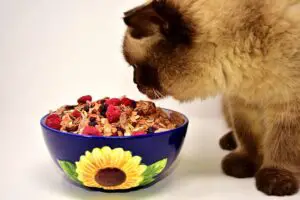
Have you ever heard of the BARF diet for your cat? Find out what it is and how it works, and what the benefits are for your kitty.
Adopting a cat means taking responsibility for its health and well-being and it is known that both things also and above all involve the nutrition that is offered to the cat: in recent years there has been a lot of talk (and continues to be talked about) about BARF diet for pets, but what is it specifically? Is this type of diet also suitable for cats? And if so, when and how should it be put into practice?
In this article, we will find out what the BARF diet is and how to switch to this type of diet for the cat, also reporting the most widespread expert opinions on the pros and cons of this diet and some useful information on preferred foods, recipes preferred by cats, special situations for cats with specific needs.
Of course, the information contained in this article is of a general nature: before making any decisions and making changes to your cat’s usual diet, it is always advisable to consult your veterinarian.
The BARF diet: is it suitable for cats?
The acronym BARF stands for Biologically Appropriate Raw Food, or “biologically appropriate raw food”.
Opinions, pros and cons of the BARF
The BARF diet was born in the early 90s and since then there have been many expert opinions on the subject.
In general, this type of natural diet, based on the prey-predator binomial, has several recognized advantages but also some disadvantages that it is important to take into consideration.
BARF diet for cats with raw food
Let’s start with the “original” version of the BARF for cats: in this case, the cat will eat raw fish and meat, albeit with due precautions.
It is undeniable, in fact, that giving raw meat to cats can have microbiological risks. Also, some foods should never be given raw, such as pork.
Offering raw meat and fish to the cat is certainly more complex than simply opening a can or a bag of crunchies.
It is necessary to inform yourself in depth, furthermore fresh food must be purchased, prepared and kept for a shorter time in the refrigerator or frozen.
Compared to the observable advantages with a raw BARF diet for the cat, odorless stools, shinier coat, healthier and cleaner teeth are found already after a few days.
In the long run, improvements in the immune system are also observed, with the result that the cat is less likely to contract diseases and parasites.
Diet for cats with cooked and homemade food
Offering the cat a diet based on cooked home food is probably simpler than the “pure” BARF and still offers a number of advantages over industrial cat food.
Cooking for the cat means offering more variety and authenticity in the bowl, even if it takes more time to prepare the food.
Furthermore, you can choose how to correctly balance the various nutrients between proteins, vitamins, fibers by choosing the right doses of meat and vegetables among the most suitable foods for feline nutrition.
In some cases, it may be necessary to give the cat supplements to ensure a healthy and complete diet, avoiding dangerous nutritional deficiencies.
Also be careful to avoid excess protein or fat, which can respectively cause kidney problems in cats or cases of dangerous feline pancreatitis.
Finally, always remember that it is essential to offer the cat top quality food and to be very careful in the case of frozen meat not to interrupt the cold chain.
How to start BARF cat feeding from scratch
But how can you start with the BARF diet with a cat, whether it is from an early age, or already as an adult?
If you start feeding the cat with the BARF diet from an early age it is certainly easier to make the kitten appreciate raw meat, which may not always be immediate when the food change is proposed to an adult cat, accustomed to dry or wet food. for commercial cats.
The first thing to do is to get informed, arm yourself with a lot of patience and above all consult the veterinarian to understand how to move in this fundamental step.
Once this is done, you can start introducing the BARF diet into the life of the cat starting from some fundamental steps:
- Fasten your cat for about 12 hours so that he will be hungry when you offer him the first meal of his new diet.
- Start introducing only one new food at a time, so that the cat can gradually get used to new tastes and textures.
- Once you have chosen the first food, add a few pieces to your cat’s normal industrial food ration.
- Day after day, reduce the amount of can or kibble in favor of the new food, also increasing the size of the pieces mixed in the baby food.
- If you don’t want to offer the raw meat directly to the cat, you can lightly sear it before placing it in the bowl. The bones should be given only later, being careful not to cook them under any circumstances: they would become soft and flake dangerously.
Recommended foods and recipes

In a BARF diet intended for cats, it is necessary to pay attention to the right amount of proteins, coming above all from meat and fish, but also to other important aspects such as the intake of fiber.
In general, about 85% of a cat’s meal must be made up of proteins which are then supplemented with fruit and vegetables suitable for the cat to add the necessary amount of fiber, vitamins, minerals and carbohydrates.
Furthermore, it is important to emphasize that raw or homemade food is naturally rich in water, providing the cat with the right degree of humidity.
Among the types of meat and fish most suitable for the cat’s BARF diet there are foods naturally rich in taurine: tuna, lamb, beef, cod, chicken are just some of the examples.
The cat can and must also eat offal: for example, it can be given chicken hearts several times a week.
In addition to meat and fish, the cat can also eat cooked eggs and vegetables (blended or not, depending on the pet’s preference).
Small amounts of grains and seeds are also excellent to supplement fiber, while salmon or cod liver oil can be used to ensure the right amount of fat.
With respect to quantities, the following rules generally apply:
- kittens puppies> 80/100 grams of meat divided into 3/4 meals a day;
- adult cats> 30/40 grams per kg of weight, divided into 2 meals a day;
- pregnant or lactating cat> 60/80 grams per kg of weight.
The BARF diet is potentially suitable for cats of all ages, although more care must be taken in the case of a growing puppy who must not lack the right amounts of nutrients to grow up.
If there are diseases, it is necessary to evaluate the situation with the help of the veterinarian: for example, cats suffering from chronic renal failure or those suffering from gastroenteritis may not be suitable for BARF feeding.






